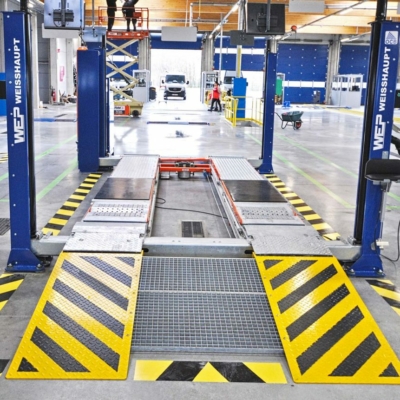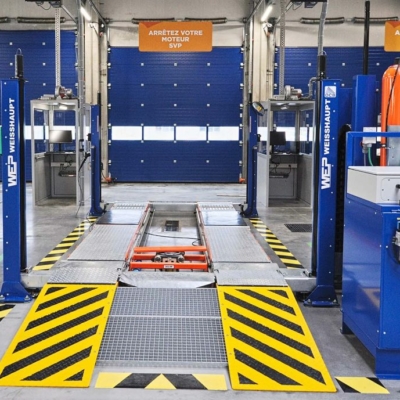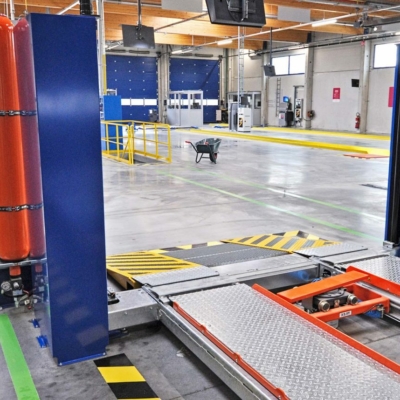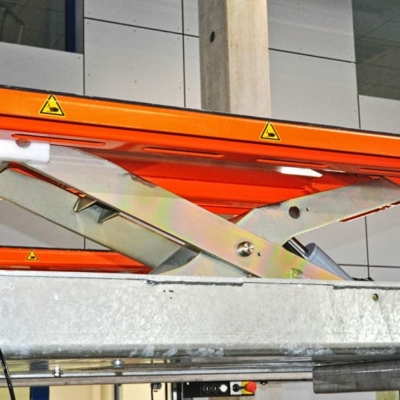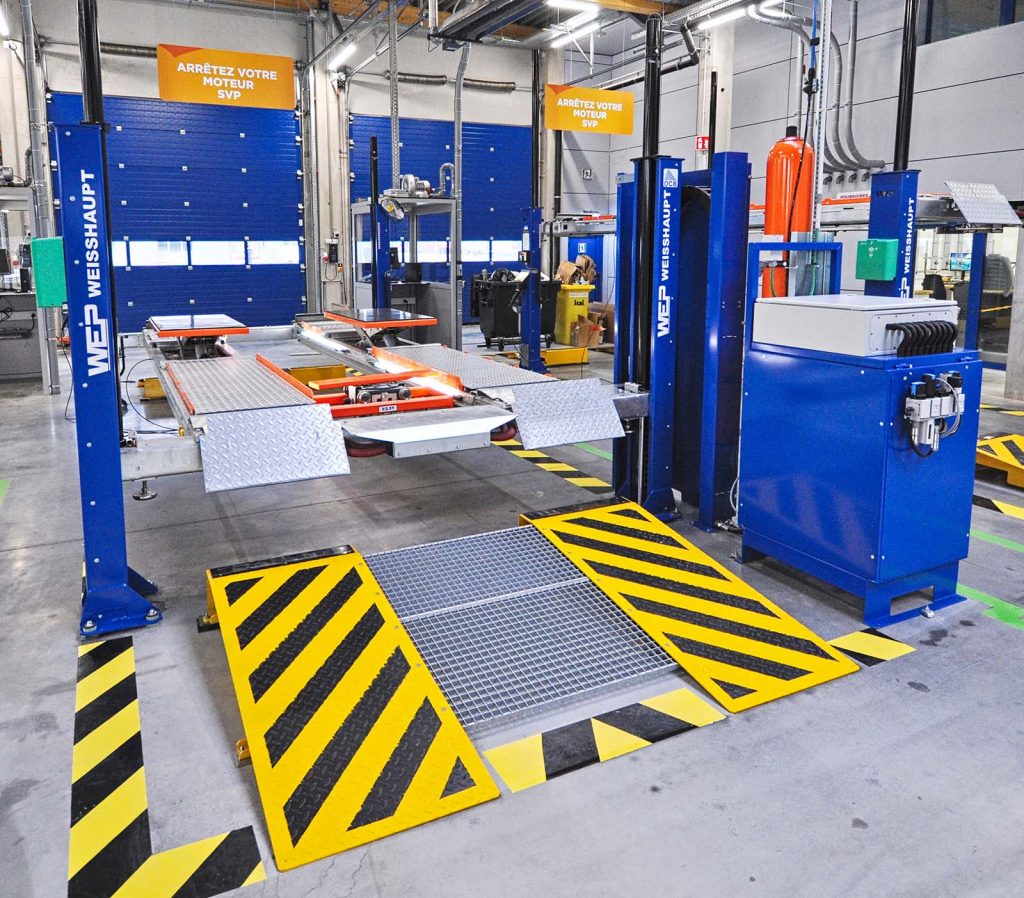automotive lifting platform
Car lifts for vehicle inspection centers
-
Nowadays, car lifts have almost completely replaced the classic inspection pits in vehicle inspection up to 3,5 tons.
And this for several reasons:
- accessibility to the vehicle to be examined: this is much higher and more comfortable with a floor-based car lift than from a pit shaft. In addition, the inside view of the wheels is much better than with a pit;
- ease of access to the vehicle parts to be checked: this is simply better with a lift, since the inspector enjoys much more freedom of movement than in the narrow pit shaft. Furthermore, the inspector can adjust the inspection height to his body size and stand upright. Our lifts lift up to 2 m high as standard and are therefore comfortable even for very tall people;
- when lifted, a lift is simply better for the external control of the critical underside of the vehicle (sills, wheel arches) than a pit, since the platform enables visual control at a comfortable eye level and not cumbersomely slipping on your knees or in a crouch;
- the lighting conditions on a car lift (especially on our four-column car lifts) cannot be compared with the pit. Lifts bring in plenty of bright daylight from the side, which makes visual inspection considerably easier and last but not least, easy on the eyes;
- a car lift reduces the frequency of sickness or (worse) accidents, which inevitably occur during operation of an inspection pit due to the constant walking down and out of the pit cellar;
- working with a car lift enables significant infrastructure savings since there is no longer any need for a pit cellar;
- a car lift makes it much easier to adapt to new testing techniques by simply replacing the old device by a new one with last level of evolution;
- in case of an emergency (fire, etc.) the escape option with a lift is of course much better than with a pit cellar, with a lot of savings in the building infrastructure;
- The fact that a lifting platform needs a lot of floor space is also a yesterday's argument, as the lifting columns on our four-post platforms are only 15 cm wide.
-
WEP-WEISSHAUPT and the automotive inspection industry: a long-term partnership!
We have been producing four-column vehicle lifts for vehicle monitoring stations since the early 2,5s. And that is no accident! R. WEISSHAUPT AG has been manufacturing four-column vehicle lifts since the mid-25s. Back then, our chain-driven lifts from XNUMXt to XNUMXt lifting capacity were legendary and were used in many car and truck workshops. Towards the beginning of the eighties, the decision was made to leave the market for mass products and to specialize in high-quality special lifts. This led to intensive collaboration with vehicle inspection center operators, who were researching more efficient working methods at the time.
The result was, among other things, the changeover to lifts as the main inspection instrument for visual inspection of the underbody, chassis parts, brakes, etc. We then developed our four-column lift specifically for this requirement profile. The third generation is now on the market. It is the perfect symbiosis of close cooperation with users and many years of experience. We are always very close to the customer with our eyes and ears.
That is more than 35 years of bundled experience in the very special segment of vehicle lifts for vehicle inspection centers - not bad, we think.
-
The following tests are carried out on the vehicles on these lifts:
- testing of all chassis components for play (suspension, steering) using integrated vibrating plates for the front and rear axles;
- visual inspection of the complete sub-floor for damage and corrosion;
- visual inspection of the drive train for wear, damage and leaks;
- check the brake system for corrosion, wear and leaks;
- visual inspection of the exhaust system for corrosion.
-
Our inspection station car lifts are all four-column devices with rails. This machine layout has proven to be ideal for vehicle test centers.
Here are some advantages:- all test procedures in the station are done on one level;
- best accessibility for the examiner from all 4 sides;
- easy to set up on the existing floor; no further and expensive ground work required;
- extremely easy to repair because it is a free-standing device;
- very low maintenance thanks to high quality components.
-
Our answer to this high requirement profile: the WEP-WEISSHAUPT electro-hydraulic four-column vehicle lift for vehicle inspection centers
WEP-VSBH 3,5t
In order to be able to fulfill the test tasks, this device is equipped with a wealth of features and technical details:
- Because of the extremely high cycle times in the inspection centers, our vehicle inspection lifts are consequently designed as electro-hydraulic devices with 4 electronically synchronized lifting cylinders, one in each in lifting column, as the load element. This direct stroke layout, together with a very powerful hydraulic unit including accumulator, guarantees extremely quiet and fast operation with lifting / lowering times of just 13 seconds! In addition, the minimalism of moving parts means minimal wear and longest service life.
- Redundant drive to avoid complete failures: the hydraulic unit is equipped with 2 pumps as standard. If a pump fails, the accumulator can continue to work at full stroke speed. The unit sits in a highly noise-insulated pump cabinet that reduces noise emissions to a barely perceptible level.
- "No break" function thanks to the accumulator: the device remains operational even in the event of a power failure. The operator is informed of the power failure by an acoustic signal. He can then still raise and lower the lift once and the vehicle does not remain blocked on the lift. Not to be underestimated at vehicle inspection centers with public traffic.
- Very high sinking comfort: our unique pneumatic locking bolts allow a considerably faster lowering due to the optimized release stroke.
- The extremely narrow overall width of the device enables perfect insertion into the test line, even in tight building conditions.
- Axle play detectors integrated in the rails with 4 movements for the front axle and cross movement for the rear axle. Our axle play detectors are characterized by their unique pneumatic drive technology of the very latest generation. It guarantees unmatched vibrating speed and an imminent reaction when changing direction. This considerably simplifies the visual inspection. The entire installed pneumatic technology is equipped with highly sensitive and extremely responsive control valves and silencers that reduce noise emissions to a minimum. In addition, the system is insensitive to breakdowns of the drive medium due to the pneumatic drive: a leak occurring in the area of the pneumatic hoses can be quickly and easily remedied on site, and the downtime is reduced to a minimum. The vibrators slide on high-precision, ball-bearing linear slide rails, so that there is virtually no friction loss. This works so well that the system can be operated with just 6 bar pressure under load. After all, the vibrating forces should arrive where they are needed – on the vehicle.
- The rails are built extremely low, thus ensuring a low approach height. A pleasant side effect: the overall length of the system could be reduced to less than 8,4 m (including ascent and descent ramps), which can be decisive when integrating the device on test lines.
- The “zero obstacle” surface is unique to our rails: the entire access level is at the same level; only the front V-vibrator plates have the recess, in which the front wheels finally drive in for the vibrating position. This architecture enables an incomparably quiet accessing of the vehicle, which brings us back to the topic of noise reduction, which has now become very important in modern work environments. We achieve this through elaborately designed transition pieces between the individual test and lifting components of the rail. Similar to driving up on the lift, driving down is equally quiet.
- This quiet traffic is reinforced by the complex synthetic storage of the ascent and descent ramps.
- Our rails are equipped as standard with a pair of electro-hydraulic wheel-free scissor jacks for classic lifting via the side skirts. These have two-way hydraulic cylinders, which also makes them unique: this design feature guarantees perfectly synchronized and rapid lowering even when the load is away from the lifting tables. To support the scissor jack, there is a pneumatic short jack between the rails for those vehicles, that must be raised at certain pick-up points. The pneumatic drive, in conjunction with the electronic proportional valve, guarantees rapid lifting and lowering movements. The lifter carriage is of course ball-bearing guided in high-precision tracks and is therefore extremely smooth-running.
- The rust protection is unique with our WEP-VSBH 3,5t! The entire platform (2 crossbeams and 2 rails including up and down ramps) is hot-dip galvanized according to EN ISO 1461 with a layer thickness of 55 µm. This means that the device is prepared for a long life in the tough everyday use of an inspection center.
- The numerical control of the device sits on the hydraulic unit cabinet and corresponds to the highest industrial standard through the use of components from well-known manufacturers. Complete machine monitoring via large four-color TFT screen. The stage is IT-compatible so that it can easily be connected to an external monitoring system.
- Operation of all test functions from a cable connected LED carrier lamp. The carrier lamp is also an in-house development and is characterized by its highly impact-resistant polyamide housing and the extremely responsive industrial micro pushbuttons, which have been tested with 2 million pressure movements.
- Possibility of installation in the floor recess provided by the customer.
-
Vehicle inspection station lifts and their noise emissions: a sensitive issue, which we are relaxed about.
Noise emissions from test equipment in vehicle inspection centers have become a catchphrase in the last 10 years, just like in other industries where equipment is running all day long.
Indeed, one should not underestimate this topic! A series of studies have been carried out to prove that people with health problems appear in work areas above certain noise levels.
In vehicle monitoring centers, it was found that the lifts, in particular, produced the loudest noise due to the vibrating movements when raised. We have fully incorporated this knowledge into the development of our last generation of car lifts. The result is a machine whose noise level is among the lowest that can be found in this product segment. There are a number of technical reasons for this:
- the lifting architecture with the 4 standing hydraulic cylinders, which are enclosed in a fist shape by the crossbeam ends and thus represent the minimum possible number of moving parts that could emit noise;
- the extremely quiet hydraulic unit, which also sits in a highly noise-insulated pump cabinet that reduces noise emissions to a barely perceptible level;
- The lowering of the platform is of course completely noiseless by opening the lowering valves.
- driving onto the lift is also extremely quiet thanks to the "zero obstacle" surface of the rails, which – as the name suggests – has no transition levels between technical components of the rails;
- the vibrating movements themselves are dampened to the maximum by the high-precision, ball-bearing linear slide rails of the vibrating plates. Furthermore, the latest pneumatic technology with very effective silencers ensures a further reduction in the noise level.
Equipped in this way, the WEP-VSBH 3,5t is a real quiet step among the vehicle inspection station lifts!
